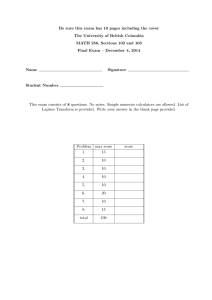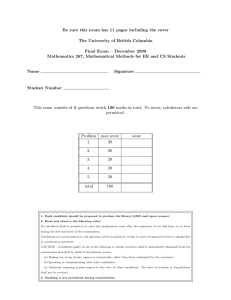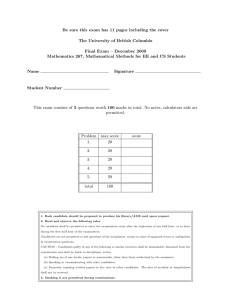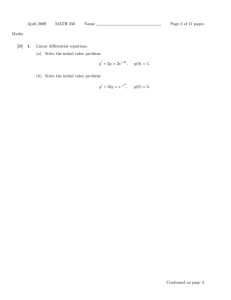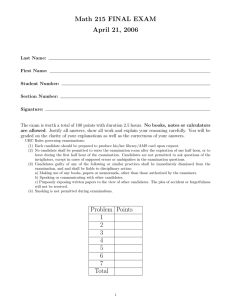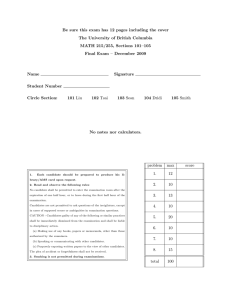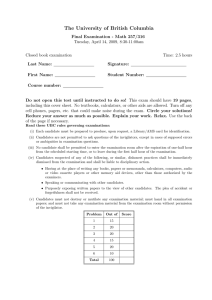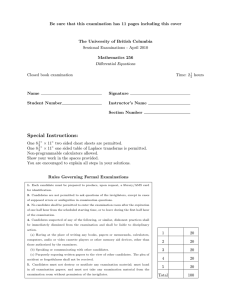Be sure that this examination has 13 pages including this... The University of British Columbia Sessional Examinations - April 2008
advertisement
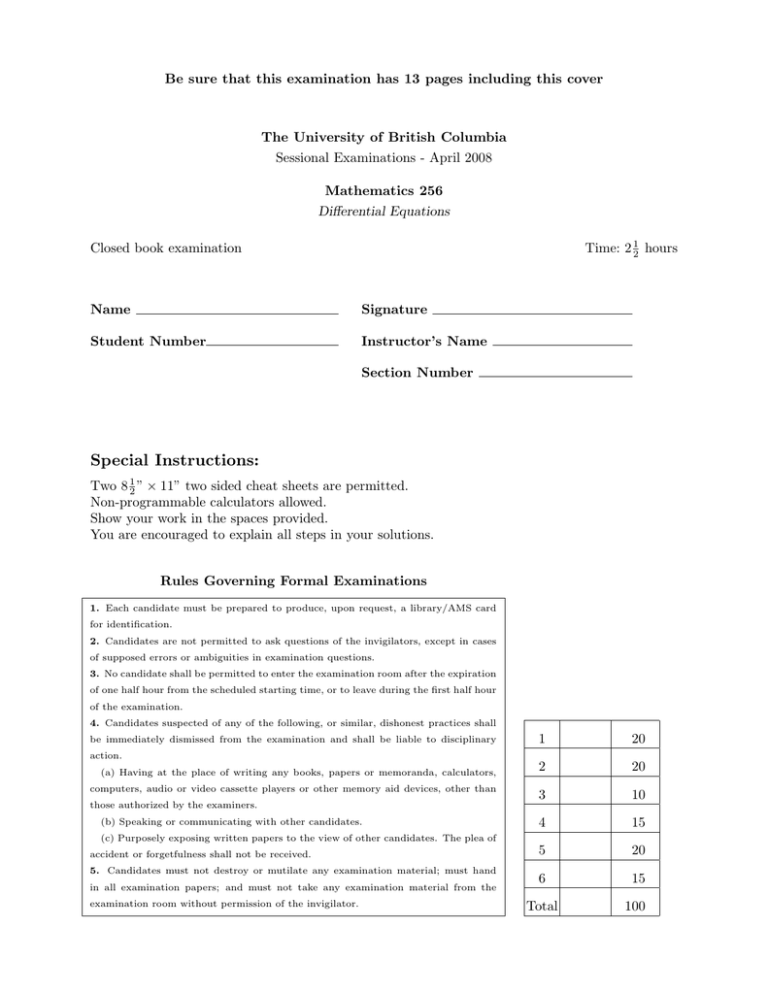
Be sure that this examination has 13 pages including this cover The University of British Columbia Sessional Examinations - April 2008 Mathematics 256 Differential Equations Time: 2 12 hours Closed book examination Name Signature Student Number Instructor’s Name Section Number Special Instructions: Two 8 12 ” × 11” two sided cheat sheets are permitted. Non-programmable calculators allowed. Show your work in the spaces provided. You are encouraged to explain all steps in your solutions. Rules Governing Formal Examinations 1. Each candidate must be prepared to produce, upon request, a library/AMS card for identification. 2. Candidates are not permitted to ask questions of the invigilators, except in cases of supposed errors or ambiguities in examination questions. 3. No candidate shall be permitted to enter the examination room after the expiration of one half hour from the scheduled starting time, or to leave during the first half hour of the examination. 4. Candidates suspected of any of the following, or similar, dishonest practices shall be immediately dismissed from the examination and shall be liable to disciplinary action. (a) Having at the place of writing any books, papers or memoranda, calculators, computers, audio or video cassette players or other memory aid devices, other than those authorized by the examiners. (b) Speaking or communicating with other candidates. 1 20 2 20 3 10 4 15 5 20 6 15 Total 100 (c) Purposely exposing written papers to the view of other candidates. The plea of accident or forgetfulness shall not be received. 5. Candidates must not destroy or mutilate any examination material; must hand in all examination papers; and must not take any examination material from the examination room without permission of the invigilator. April 2008 MATH 256 Name Page 2 of 13 pages Marks [20] 1. Linear 2nd order differential equations. (a) Show that the equation t2 y 00 + 6ty 0 + 4y = 0, has 2 solutions of form tn , i.e. find these solutions. (b) Show that the 2 solutions in part (a) are linearly independent and hence write down the general solution of the above equation. Continued on page 3 April 2008 MATH 256 Name Page 3 of 13 pages (c) Find a particular solution to t2 y 00 + 6ty 0 + 4y = 28t3 , and hence find the solution to this inhomogeneous problem that satisfies initial conditions y(1) = 1, y 0 (1) = 0. Continued on page 4 April 2008 [20] 2. MATH 256 Name Consider the equation: Page 4 of 13 pages y 00 + βy 0 + 2y = g(t) which models a damped forced oscillator for β > 0. (a) Writing x = (x1 , x2 )T where x1 = y and x2 = y 0 , transform this equation into a 2 x 2 linear system: x0 = Ax + f , i.e. derive the expressions for the matrix A and vector function f . (b) Assume that g(t) = 0. Find the general solution of the homogeneous system: x0 = Ax (i) for β = 2; (ii) for β = 3. Continued on page 5 April 2008 MATH 256 Name Page 5 of 13 pages (c) Sketch the phase plane close to x = 0 for the two above cases: (i) β = 2; (ii) β = 3. At what value of β does the phase plane change between these two qualitatively different solutions? (d) For β = 2 and assuming g(t) = e−t , find the general solution of the inhomogeneous system: x0 = Ax + f . Continued on page 6 April 2008 [10] 3. MATH 256 Name Page 6 of 13 pages Use Laplace transforms to solve the following initial value problem: 5 y 00 + y 0 + y = t − u2 (t)(t − 2) − 2u4 (t), 4 y(0) = y 0 (0) = 0. Continued on page 7 April 2008 [15] 4. MATH 256 Name Page 7 of 13 pages The function f (x) is defined for x ∈ [0, 1] by f (x) = −0.5(x2 + x) (a) Sketch the odd and even extensions of f (x) to the interval x ∈ [−1, 1]. (b) Find the Fourier cosine series for f (x). To what value does the Fourier series converge to at x = 1? Continued on page 8 April 2008 MATH 256 Name Page 8 of 13 pages (c) Find the Fourier sine series for f (x). To what value does the Fourier series converge to at x = 1? Continued on page 9 April 2008 [20] 5. MATH 256 Name Page 9 of 13 pages Consider the the following IBVP ut = uxx − 1, 0 < x < 1, t ≥ 0, subject to the conditions: u(0, t) = 0, u(1, t) = 1, u(x, 0) = 0. (a) Writing u(x, t) = us (x) + v(x, t) state the problems that are satisfied by the steady state solution, us (x), and the transient solution v(x, t). (b) Find the steady state solution, us (x). Continued on page 10 April 2008 MATH 256 Name Page 10 of 13 pages (c) Find the transient solution, v(x, t) using separation of variables. Hint: you may save some time with the initial conditions by using the results from question 4. Continued on page 11 April 2008 MATH 256 Name Page 11 of 13 pages (d) Using the 1st term in the series solution for v(x, t) estimate how long it takes for |v(x, t)| to decay to 1% of its initial size at x = 0.5. Continued on page 12 April 2008 [15] 6. MATH 256 Name Page 12 of 13 pages Use separation of variables to solve the BVP: uxx + uyy = 0, 0 < x < 1, 0 < y < 1, subject to the conditions: u(0, y) = 0, u(1, y) = 0, u(x, 0) = 0, u(x, 1) = sin 3πx. Continued on page 13 April 2008 MATH 256 Name Page 13 of 13 pages The End
